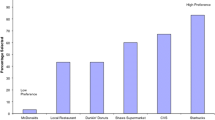Abstract
Critical to the effectiveness of any positive behavioral intervention is the use of preferred stimuli that are likely to function as reinforcers. When preferred items cannot be used on a continuous basis, are prone to satiation, or are inappropriate for use in a given setting, alternate steps must be taken to ensure reinforcer potency. In this 2-experiment study we assessed accuracy of pictorial choice preference assessment (PCPA) and examined 2 methods for conditioning reinforcing properties to low preference items. Participants included three 12-year-old students with mild or moderate mental retardation. Only partial support for the predictive validity of PCPA was provided in Experiment 1, and conditioning effects were minimal and short lived. Results of Experiment 2 suggested that pairing low preferred items with a choice of multiple, highly preferred items may be an effective means of establishing the former as conditioned reinforcers.
Similar content being viewed by others
REFERENCES
Berkowitz, M. J., and Martens, B. K. (2001). Assessing teachers' and students' preferences for school-based reinforcers: Agreement across methods and different effort requirements. J. Dev. Phys. Disabil. 13: 373–387.
Cosden, M., Gannon, C., and Haring, T. G. (1995). Teacher control versus student control over choice of task and reinforcement for students with severe behavior problems. J. Behav. Educ. 5: 11–27.
Fisher, W., Piaza, C. C., Bowman, L. G., Hagopian, L. P., Owens, J. C., and Slevin, I. (1992). A comparison of two approaches for identifying reinforcers for person with severe and profound disabilities. J. Appl. Behav. Anal. 25: 491–498.
Gresham, F. M., Watson, T. S., and Skinner, C. H. (2001). Functional behavioral assessment: Principles, procedures, and future directions. Sch. Psychol. Rev. 30(2): 156–172.
Higgins, J. W., Williams, R. L., and McLaughlin, T. F. (2001). The effects of a token economy employing instructional consequences for a third-grade student with learning disabilities: A data-based case study. Educ. Treat. Child. 24: 99–106.
Kern, L., and Marder, T. J. (1996). A comparison of simultaneous and delayed reinforcement as treatments for food selectivity. J. Appl. Behav. Anal. 29: 243–246.
Kern, L., Vorndran, C. M., Hilt, A., Ringdahl, J. E., Adelman, B. E., and Dunlap, G. (1998). Choice as an intervention to improve behavior: A review of the literature. J. Behav. Educ. 8(2): 151–169.
Lalli, J. S., Mauro, B. C., and Mace, F. C. (2000). Preference for unreliable reinforcement in children with mental retardation: The role of conditioned reinforcement. J. Appl. Behav. Anal. 33: 533–544.
Logan, P., and Skinner, C. H. (1998). Improving students' perception of a mathematics assignment by increasing problem completion rates: Is problem completion a reinforcing event? Sch. Psychol. Q. 13: 322–331.
Martens, B. K., Muir, K. A., and Meller, P. J. (1988). Rewards common to the classroom setting: A comparison of regular and self-contained room student ratings. Behav. Disord. 13: 169–174.
Michael, J. (2000). Implications and refinements of the establishing operation concept. J. Appl. Behav. Anal. 33: 401–410.
Northup, J., George, T., Jones, K., Broussard, C., and Vollmer, T. R. (1996). A comparison of reinforcer assessment methods: The utility of verbal and pictorial choice procedures. J. Appl. Behav. Anal. 29: 201–212.
Northup, J., Jones, K., Broussard, C., and George, T. (1995). A preliminary comparison of reinforcer assessment methods for children with attention deficit hyperactivity disorder. J. Appl. Behav. Anal. 28: 99–100.
O'Reilly, M. F. (1999). Effects of presession attention on the frequency of attention-maintained behavior. J. Appl. Behav. Anal. 32: 371–374.
Pace, G. M., Ivanic, M. T., Edwards, G. L., Iwata, B. A., and Page, T. J. (1985). Assessment of stimulus preference and reinforcer value with profoundly retarded individual. J. Appl. Behav. Anal. 18(3): 249–255.
Pierce, W. D., and Epling, W. F. (1995). Behavior Analysis and Learning, Prentice-Hall, Englewood Cliffs, NJ.
Shapiro, E. S. (1996). Academic Skills Problems, Guilford, New York.
Silver, Burdett, and Ginn, Inc. (1991). Word of Reading. Morristown, NJ.
Windsor, J., Piche, L. M., and Locke, P. A. (1994). Preference testing: A comparison of two presentation methods. Res. Dev. Disabil. 15: 439–455.
Author information
Authors and Affiliations
Corresponding author
Rights and permissions
About this article
Cite this article
Ardoin, S.P., Martens, B.K., Wolfe, L.A. et al. A Method for Conditioning Reinforcer Preferences in Students with Moderate Mental Retardation. Journal of Developmental and Physical Disabilities 16, 33–51 (2004). https://doi.org/10.1023/B:JODD.0000010038.69725.88
Issue Date:
DOI: https://doi.org/10.1023/B:JODD.0000010038.69725.88




